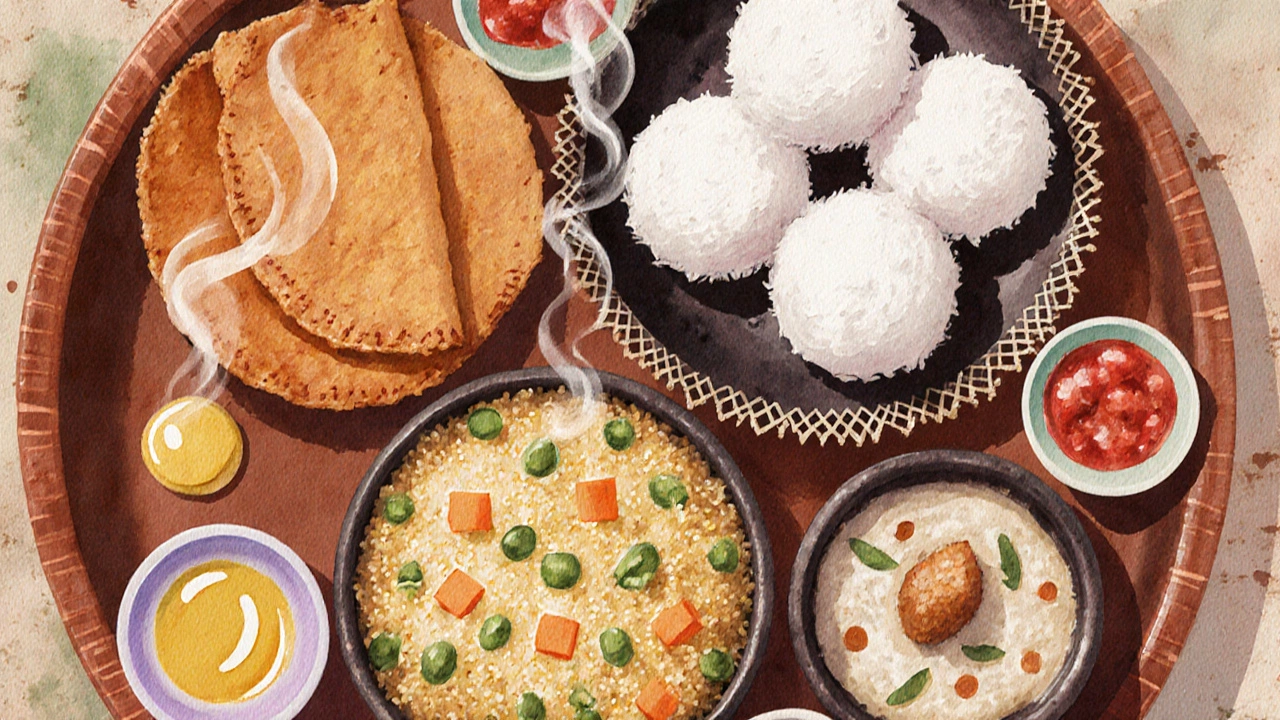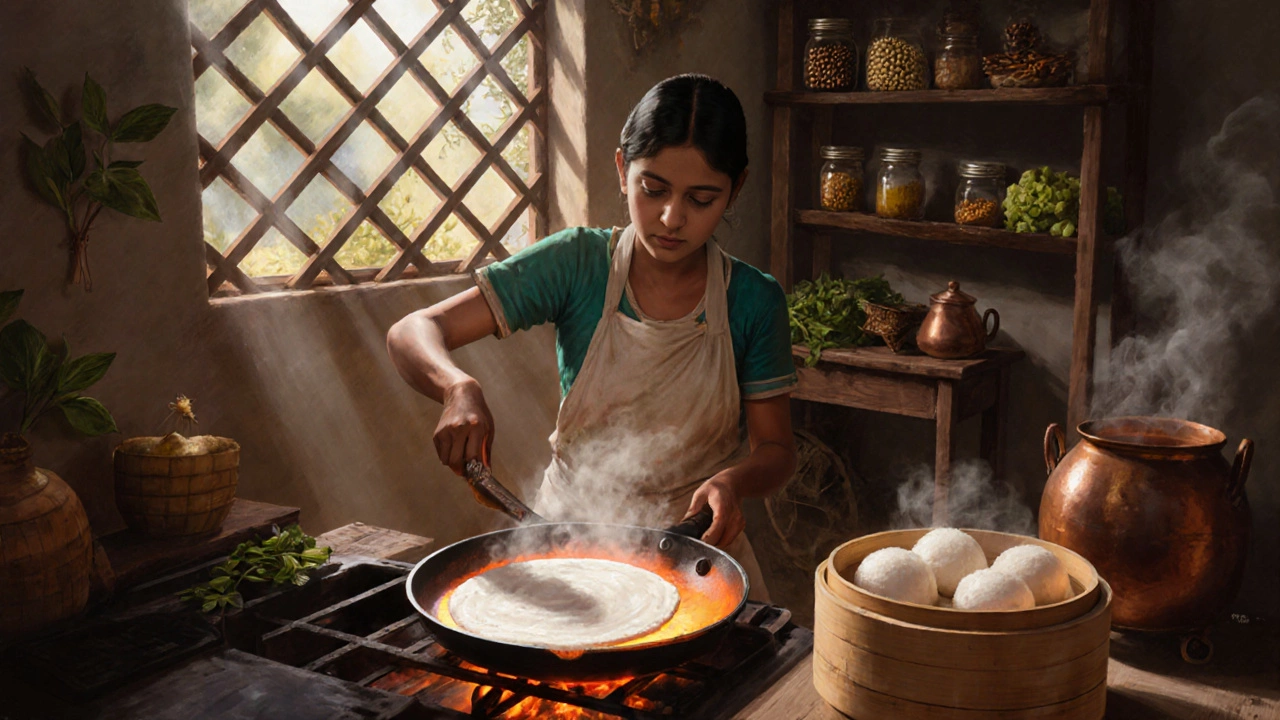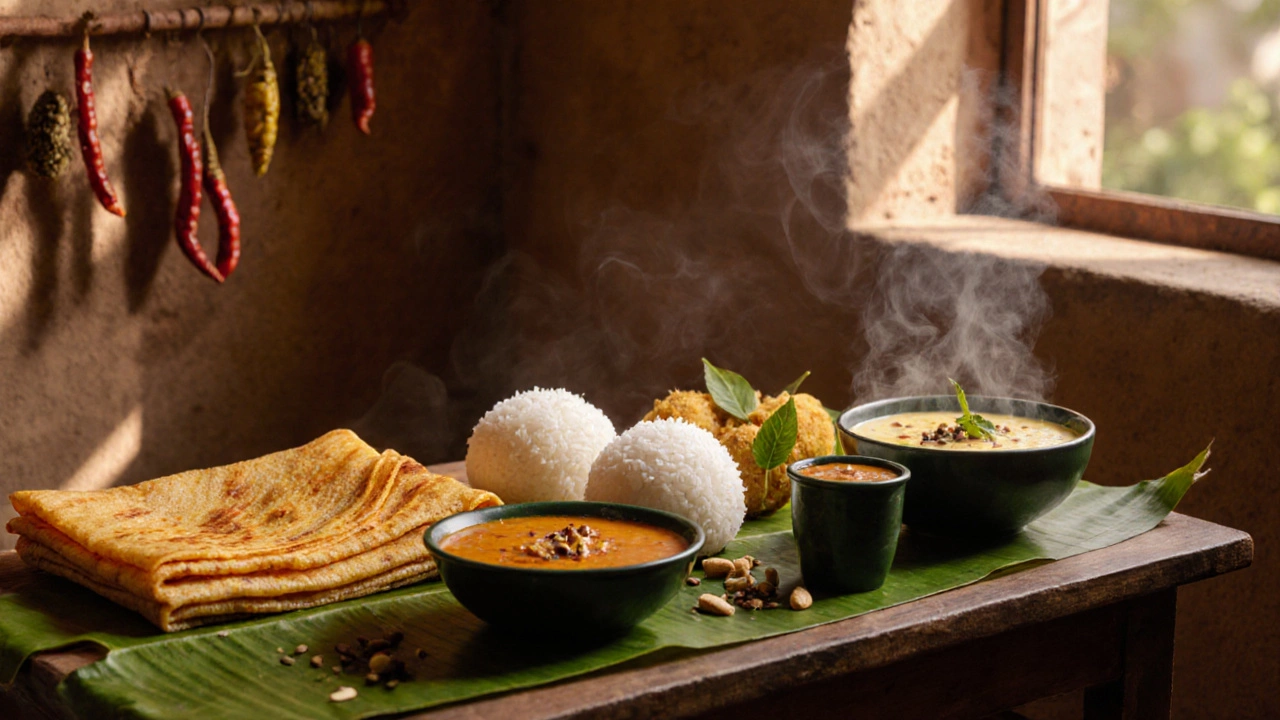Ever wondered what people in the southern states of India call the tasty dishes they eat for the first meal of the day? The answer is a colorful mix of names like South Indian breakfast, each with its own story, texture, and flavor. In this guide we’ll break down the most common dishes, explain where the names come from, and give you quick tips to try them at home.
What does "South Indian breakfast" actually mean?
South Indian breakfast is a collective term for the morning meals popular in the four southern states of India - Tamil Nadu, Karnataka, Kerala, and Andhra Pradesh. These dishes usually rely on rice or lentil batter, are lightly spiced, and are accompanied by coconut‑based chutneys and sambar (a tangy vegetable stew). The focus is on light yet satisfying foods that give you energy for the day.
Core dishes you’ll hear about
Let’s dive into the staples that define a South Indian morning.
- Dosa is a thin, crispy crepe made from fermented rice and urad dal (black gram) batter. It’s cooked on a hot griddle and served rolled or folded with chutney and sambar. The word “dosa” comes from the Tamil ‘dosai’, meaning “pancake”.
- Idli are soft, steamed cakes also made from fermented rice and urad dal batter. Their fluffy texture comes from the fermentation process, and they’re often paired with coconut chutney or podi (spiced lentil powder). The name “idli” derives from the Tamil word ‘idli’, meaning “steamed”.
- Upma is a savory porridge prepared from roasted semolina (rava) or coarse rice flour, cooked with vegetables, mustard seeds, and curry leaves. The term “upma” means “to be mixed” in Telugu, reflecting the way the ingredients are tossed together.
- Vada refers to deep‑fried doughnuts made from urad dal or chana dal batter, seasoned with black pepper, cumin, and curry leaves. They’re crunchy on the outside, soft inside, and often called “medu vada” (soft vada) in Tamil.
- Pongal is a one‑pot rice-and-moor (yellow lentil) dish, seasoned with cumin, black pepper, ginger, and ghee. The name “pongal” comes from the Tamil verb meaning “to boil over”, describing the simmering process.
- Appam is a soft, bowl‑shaped pancake made from fermented rice flour and coconut milk. It’s popular in Kerala and has a lacy edge with a fluffy centre. The word “appam” is Malayalam for “bread”.
- Pesarattu is a thin green gram (moong dal) crepe, flavored with ginger and green chilies. It’s a specialty of Andhra Pradesh and often served with upma inside, called “upma pesarattu”.
How the names reflect culture and language
Each dish’s name is rooted in the local language - Tamil, Telugu, Malayalam, or Kannada. The naming convention usually describes the cooking method (e.g., “idli” for steaming) or the shape (e.g., “appam” for its bowl‑like form). Because the four states share similar staple ingredients but differ in dialects, you’ll hear the same food called “dosai” in Tamil Nadu and “dose” in Karnataka, for instance.

Quick comparison of the most popular items
| Dish | Main ingredient | Cooking method | Typical texture | Common accompaniments |
|---|---|---|---|---|
| Dosa | Rice & urad dal batter | Griddle‑fried | Crispy edges, soft centre | Sambar, coconut chutney |
| Idli | Rice & urad dal batter | Steamed | Fluffy, sponge‑like | Coconut chutney, podi |
| Upma | Semolina (rava) or rice flour | Sautéed & simmered | Moist, grainy | Coconut chutney, lemon wedges |
| Vada | Urad dal or chana dal batter | Deep‑fried | Crunchy outside, soft inside | Sambar, chutney |
| Pongal | Rice & moong dal | One‑pot simmer | Soft, creamy | Ghee, cashew topping |
| Appam | Rice flour & coconut milk | Pan‑cooked (similar to pancake) | Lacy edges, airy centre | Stew, banana chips |
| Pesarattu | Green gram (moong dal) batter | Griddle‑fried | Thin, slightly crisp | Upma stuffing, chutney |
Making a simple South Indian breakfast at home
If you’re new to these dishes, start with the easiest - idli and upma. Both require minimal equipment and can be prepared in under an hour.
- Idli: Soak equal parts rice and urad dal for 4‑6hours. Grind to a smooth batter, let it ferment overnight (12‑14hours). Spoon into idli molds and steam for 10‑12minutes. Serve hot with coconut chutney.
- Upma: Roast 1cup semolina in a dry pan until golden. In another pan, heat 2tbsp oil, add mustard seeds, curry leaves, chopped onion, and mixed veggies. Add 2cups water, bring to boil, then stir in roasted semolina. Cook 3‑4minutes, garnish with roasted nuts.
Both dishes showcase the signature lightness of a South Indian breakfast while keeping the process beginner‑friendly.
Regional twists you might encounter
Even within the south, each state has its own spin:
- Tamil Nadu: You’ll see “rava dosa” (semolina‑based) and “paper dosa” (extra‑thin). Coconut chutney often includes roasted chana dal.
- Karnataka: “Mysore masala dosa” is stuffed with a spicy potato mixture. “Bisi bele bhath” (spiced rice) sometimes appears as a hearty breakfast.
- Kerala: “Puttu” (steamed rice flour cylinders) paired with banana and kadala curry is a typical morning combo.
- Andhra Pradesh: “Garelu” (lentil vada) and “upma pesarattu” are favorites, often spicier than neighboring states.
Knowing these nuances helps you recognize the dish when you travel or order at a restaurant.

Tips to get the authentic flavor
- Fermentation matters: For idli, dosa, and appam, let the batter rest at room temperature for at least 8hours. This develops the signature tangy aroma.
- Use fresh curry leaves: They add a citrusy punch that defines South Indian dishes.
- Temper with mustard seeds: A quick “tempering” (tadka) of mustard, dried red chilies, and urad dal in hot oil lifts the whole plate.
- Serve hot: These breakfast items lose their texture quickly; serve immediately after cooking.
Where to find South Indian breakfast outside India
Many Indian restaurants abroad label a section as “South Indian”. Look for terms like "Idli & Dosa", "Kerala Cuisine", or "Andhra Meals" on the menu. In cities with a sizable Indian diaspora (e.g., Auckland, London, Singapore), you’ll often see a dedicated breakfast counter offering these classic dishes.
Frequently Asked Questions
What is the main difference between dosa and appam?
Dosa is made from a rice‑urad dal batter that’s fermented and cooked thin on a flat griddle, resulting in a crisp crepe. Appam uses a rice flour and coconut milk batter, also fermented, but it’s poured into a hot pan to form a bowl‑shaped pancake with a soft centre and lacy edges. The key distinction is the batter composition and the shape.
Can I make idli without a special steamer?
Yes. A regular metal pot with a lid works fine - just place a small stand (like a metal ring or a steaming rack) inside, add water, and bring it to a gentle boil. Then place the idli molds on the stand, cover, and steam for about 12minutes.
Is upma gluten‑free?
Traditional upma uses semolina (also called rava), which is wheat‑based, so it’s not gluten‑free. However, you can substitute it with rice‑flour upma or millet flakes to keep the dish safe for gluten‑intolerant diets.
Why do South Indian breakfasts often come with sambar?
Sambar is a lentil‑based vegetable stew flavored with tamarind and a blend of spices called sambar powder. It adds protein, moisture, and a tangy depth that balances the relatively mild taste of dishes like dosa and idli, making the meal more filling.
Which South Indian breakfast is the healthiest?
Idli is often considered the healthiest because it’s steamed, low in fat, and made from fermented batter that aids digestion. Pair it with a vegetable‑rich sambar and coconut chutney for a balanced protein‑carb‑fat mix.
Now you know the names, origins, and how to enjoy a true South Indian breakfast. Whether you’re cooking at home or ordering at a local Indian eatery, you can confidently pick the right dish and appreciate the culture behind it.
